- Publisher's Note
- Editorial
- Looking from the Other Side
- Women in Rabindranath Tagore's Paintings
- Ramkinkar Baij's Santhal Family
- The Birth of Freedom in Moments of Confinement
- Jamini Roy's Art in Retrospect
- The Great Journey of Shapes: Collages of Nandalal Bose
- Haripura Posters by Nandalal Bose: The Context and the Content
- The Post-1960s Scenario in the Art of Bengal
- Art Practice in and Around Kolkata
- Social Concern and Protest
- The Dangers of Deifications
- Gobardhan Ash: The Committed Artist of 1940-s
- Gopal Ghose
- Painting of Dharmanarayan Dasgupta: Social Critique through Fantasy and Satire
- Asit Mondal: Eloquence of Lines
- The Experiential and Aesthetic Works of Samindranath Majumdar
- Luke Jerram: Investigating the Acoustics of Architecture
- Miho Museum: A Structure Embedded in the Landscape
- Antique Victorian Silver
- Up to 78 Million American Dollars1 !
- Random Strokes
- Are We Looking At the Rise of Bengal
- Art Basel and the Questions it Threw Up
- What Happened and What's Forthcoming
- Art Events Kolkata, May – June 2012
- Mumbai Art Sighting
- Delhi Dias
- Art Bengaluru
- Preview June, 2012 – July, 2012
- In the News, June 2012
ART news & views
Art Practice in and Around Kolkata
Issue No: 30 Month: 7 Year: 2012
by Nanak Ganguly
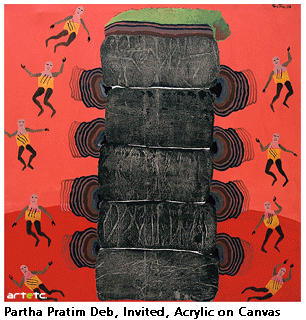
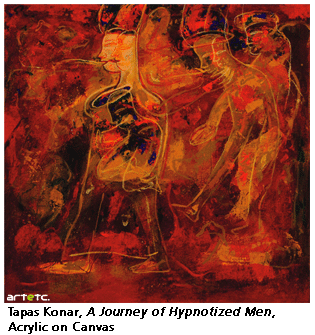


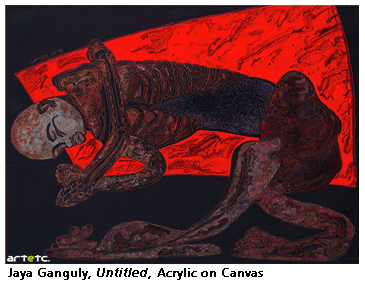 Contemporary India may be said to be in the throes of a transitionality that defines itself in terms of a challenge in political theory and to earlier paradigms of nationhood, governmentalism and developmentalism. Art practice since the mid-eighties has been witnessing the emergence of confident multilingual and divergent expressions of contemporaneity in the works of various artists like Partha Pratim Deb, Jayashree Chakravarty, Jaya Ganguly, Chittrovanu Mazumdar, Aditya Basak, Chhatrapati Dutta, Sunil De, Sekhar Roy, Amitava Dhar, Chandra Bhattacharya, Tapas Konar, Samindranath Majumdar, Paula Sengupta, Nobina Gupta, Adip Datta, Debanjan Roy, Ritendra Roy, Rajesh Deb, Nantu Behari Das, Bhabatosh Sutar and young artists like Sagar Bhowmick, Riya Chatterjee, Priyanka Lahiri, Sanhita Banerjee, Oli Ghosh, Saptarshi Naskar, Soma Das, Debasish Sarkar, Dipta Bhattacharya, Partha Guin and others featured in Gen Next exhibitions. Rapid political, economic, social and cultural upheavals have taken place over the last one decade fuelled by a world order. In the sphere of culture and the arts, these new reflections manifest themselves as a series of questions, about how to rediscover domestic/indigenous spaces without disengaging the world system. Probably one zealous orthodoxy gives way to another. Even the trivialization of sexuality is especially ironic. For one of the ironic achievements of cultural theory that preceded this has been to establish gender and sexuality as legitimate objects of study, as well as matters of insistent political importance. It is remarkable how in intellectual life the advent of sexuality and popular culture as chief ingredients of study has helped to demolish the puritan dogma that seriousness is one thing and pleasure another. Cut- edge artists of the present reason out proposition for locating the subversion of art practice in the interstices of urban spaces and beyond. Intellectual matters are no longer an ivory tower affair, but belong to the world of media, and shopping malls, bedrooms and brothels-they rejoin everyday life seamlessly.
Contemporary India may be said to be in the throes of a transitionality that defines itself in terms of a challenge in political theory and to earlier paradigms of nationhood, governmentalism and developmentalism. Art practice since the mid-eighties has been witnessing the emergence of confident multilingual and divergent expressions of contemporaneity in the works of various artists like Partha Pratim Deb, Jayashree Chakravarty, Jaya Ganguly, Chittrovanu Mazumdar, Aditya Basak, Chhatrapati Dutta, Sunil De, Sekhar Roy, Amitava Dhar, Chandra Bhattacharya, Tapas Konar, Samindranath Majumdar, Paula Sengupta, Nobina Gupta, Adip Datta, Debanjan Roy, Ritendra Roy, Rajesh Deb, Nantu Behari Das, Bhabatosh Sutar and young artists like Sagar Bhowmick, Riya Chatterjee, Priyanka Lahiri, Sanhita Banerjee, Oli Ghosh, Saptarshi Naskar, Soma Das, Debasish Sarkar, Dipta Bhattacharya, Partha Guin and others featured in Gen Next exhibitions. Rapid political, economic, social and cultural upheavals have taken place over the last one decade fuelled by a world order. In the sphere of culture and the arts, these new reflections manifest themselves as a series of questions, about how to rediscover domestic/indigenous spaces without disengaging the world system. Probably one zealous orthodoxy gives way to another. Even the trivialization of sexuality is especially ironic. For one of the ironic achievements of cultural theory that preceded this has been to establish gender and sexuality as legitimate objects of study, as well as matters of insistent political importance. It is remarkable how in intellectual life the advent of sexuality and popular culture as chief ingredients of study has helped to demolish the puritan dogma that seriousness is one thing and pleasure another. Cut- edge artists of the present reason out proposition for locating the subversion of art practice in the interstices of urban spaces and beyond. Intellectual matters are no longer an ivory tower affair, but belong to the world of media, and shopping malls, bedrooms and brothels-they rejoin everyday life seamlessly.
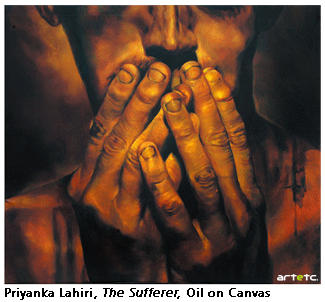
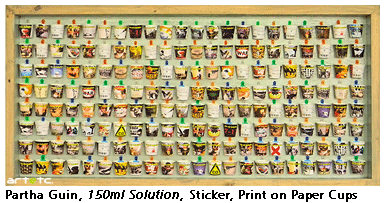 Some of these practitioners dwell on the characters, messages, and vicissitudes of physical and emotional reality inherent in New Media installations in the very definition of real is; that of which it is possible to give an equivalent reproduction. The real is not only that which can be reproduced, but which is always already reproduced. Throughout these works in the last few years there is challenge, both in its formal construction and in the themes these artists tackle. That of the artist's struggle with inhibitions, contradictions, disillusionment, political and personal isolation. Each new step, each new possibility retreats into old solutions and is discarded. But it would be impossible to stop- one has to create the text in spite of the odds. Partha Guin's work confronts our traditional experience of sound, of light, of setting-these are wrenched out of context, re-ordered and returned to a new, subtle questioning role of reflecting the artist's choice of subject. Perhaps it is already time for a moratorium on things; a temporary withdrawal from real objects during which the object analogue formed in consciousness may be examined as the origin of a new generating system. Another historic gain achieved by these artists have to establish popular culture is also worth studying. Traditional scholarship has for centuries ignored the everyday life of a commoner. Today the scene is different. It is generally recognized that everyday life is quite as intricate, unfathomable, obscure and occasionally tedious and eminently worth investigating. Today what is worth studying is not necessarily how futile, monotonous and esoteric your subject of study is.
Some of these practitioners dwell on the characters, messages, and vicissitudes of physical and emotional reality inherent in New Media installations in the very definition of real is; that of which it is possible to give an equivalent reproduction. The real is not only that which can be reproduced, but which is always already reproduced. Throughout these works in the last few years there is challenge, both in its formal construction and in the themes these artists tackle. That of the artist's struggle with inhibitions, contradictions, disillusionment, political and personal isolation. Each new step, each new possibility retreats into old solutions and is discarded. But it would be impossible to stop- one has to create the text in spite of the odds. Partha Guin's work confronts our traditional experience of sound, of light, of setting-these are wrenched out of context, re-ordered and returned to a new, subtle questioning role of reflecting the artist's choice of subject. Perhaps it is already time for a moratorium on things; a temporary withdrawal from real objects during which the object analogue formed in consciousness may be examined as the origin of a new generating system. Another historic gain achieved by these artists have to establish popular culture is also worth studying. Traditional scholarship has for centuries ignored the everyday life of a commoner. Today the scene is different. It is generally recognized that everyday life is quite as intricate, unfathomable, obscure and occasionally tedious and eminently worth investigating. Today what is worth studying is not necessarily how futile, monotonous and esoteric your subject of study is.
A recurrent issue in the new media most often is the plight of the individual in a highly technological world. However, these works are ultimately optimistic although bristling with images of war, aggression, confrontation, displacement, there is a sense, achieved through ironic focus, that beyond lies something more hopeful but first it is necessary to overturn what we have and create the neutral space from which new things shall grow. A decade back artists began to combine image and text and over the last decade, these works have increased in subtlety and in the interplay of meanings. Today's new media artist opposes what he calls the old-fashioned “logocentric” Renaissance view of painting's “presence” with an art whose new apparatus include the notion of the institution and which uses today's primary means of communication , photography , video, cinema, television. The use of the despised medium, and a critique of the means of production led this practitioners to cast conceptual art as gesture not of denial but of opening up of the institution of art to the world outside, letting other crucial disciplines. These include linguistics, semiological analysis, political theory and above all psychoanalysis.
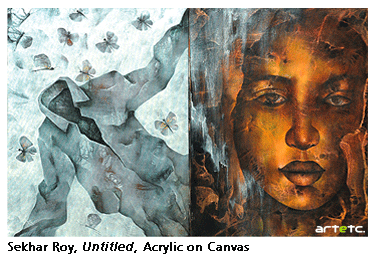
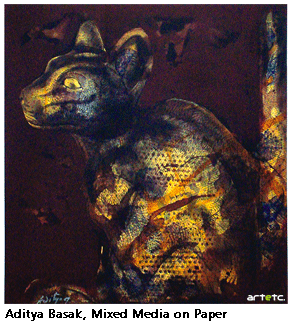 Jaya Ganguly, Aditya Basak, Amitava Dhar, Sekhar Roy and others emerged into the scene when the golden age of Abstract Expressionism was on a swansong, but that didn't prevent the gestural from making its claim. For many artists, gesture is no longer embedded in the same pictorial and referential structures from which it drew its original authority. Rather than being the basis for a dynamic compositional system or a clearly labeled marker of the psyche, it has become increasingly autonomous. The works here speak to contemporary abstractions continuing fascination with the isolation and depersonalization of the autographic gesture. Someone like Sunil De gives as examples of these obstacles: memory, history and geometry. These works suggest a passage of time for Sunil, an extremely precocious painter in his early years, both in time, his own evolution and the body he produces. The dynamism in the present series is a subtle indication of changed circumstances.
Jaya Ganguly, Aditya Basak, Amitava Dhar, Sekhar Roy and others emerged into the scene when the golden age of Abstract Expressionism was on a swansong, but that didn't prevent the gestural from making its claim. For many artists, gesture is no longer embedded in the same pictorial and referential structures from which it drew its original authority. Rather than being the basis for a dynamic compositional system or a clearly labeled marker of the psyche, it has become increasingly autonomous. The works here speak to contemporary abstractions continuing fascination with the isolation and depersonalization of the autographic gesture. Someone like Sunil De gives as examples of these obstacles: memory, history and geometry. These works suggest a passage of time for Sunil, an extremely precocious painter in his early years, both in time, his own evolution and the body he produces. The dynamism in the present series is a subtle indication of changed circumstances.
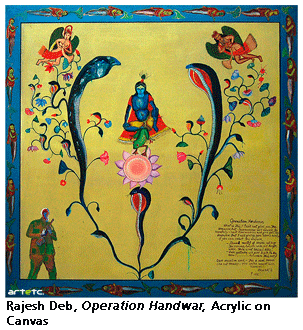 For many artists, gesture is no longer embedded in the same pictorial and referential structures from which it drew its original authority. Rather than being the basis for a dynamic compositional system or a clearly labeled marker of the psyche, it has become increasingly autonomous. In these artist's vision, each work in the present series is a distillation of a specific moment; an energetic figuration notable for its fluid brushwork. The body of work subtly suggests their lines advancing into a grand scale full of faintest of incidents. In layers of gestural brushstrokes that suggest movement in space, the artist captures the rich drama of the soul. Take the example of Rajesh Deb. Is he a painter or a printmaker who makes single wood cut prints? His spirited and agile interlocution of a lost world of nineteenth century Calcutta and agelessness, tells us engraved stories of a cultural space as we read them again and again: bristling with drama, thick with dialogue, vividly rendered and studded with astringent apercus and submerges them to the present tropes of our times. He takes the print of an image printed from the raised surface of a plywood block, from which the white areas of the design have been cut away and transfers them to a canvas. Wood is the most frequently used material that he uses and paints them with acrylics. Texture is an important attribute in these big sized monoprints which is achieved through intricate dividing and layering of the ground. The patterning of separate areas sets off these spaces giving each its own depth and providing body to the visual text.
For many artists, gesture is no longer embedded in the same pictorial and referential structures from which it drew its original authority. Rather than being the basis for a dynamic compositional system or a clearly labeled marker of the psyche, it has become increasingly autonomous. In these artist's vision, each work in the present series is a distillation of a specific moment; an energetic figuration notable for its fluid brushwork. The body of work subtly suggests their lines advancing into a grand scale full of faintest of incidents. In layers of gestural brushstrokes that suggest movement in space, the artist captures the rich drama of the soul. Take the example of Rajesh Deb. Is he a painter or a printmaker who makes single wood cut prints? His spirited and agile interlocution of a lost world of nineteenth century Calcutta and agelessness, tells us engraved stories of a cultural space as we read them again and again: bristling with drama, thick with dialogue, vividly rendered and studded with astringent apercus and submerges them to the present tropes of our times. He takes the print of an image printed from the raised surface of a plywood block, from which the white areas of the design have been cut away and transfers them to a canvas. Wood is the most frequently used material that he uses and paints them with acrylics. Texture is an important attribute in these big sized monoprints which is achieved through intricate dividing and layering of the ground. The patterning of separate areas sets off these spaces giving each its own depth and providing body to the visual text.
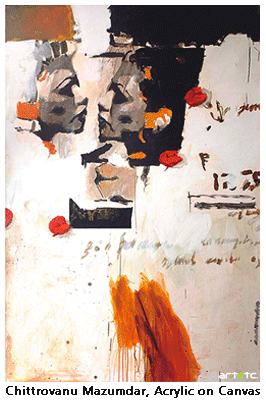 The present process of making the process, the continual erasing of memory and reconstruction and reworking of material is a reflection of an erasure that reflects our spoilt ad scarred landscape- Chittrovanu Mazumdar installations. Each new step, each new possibility retreats into old solutions and is discarded. But it would be impossible to stop- one has to create the text in spite of the odds. It confronts our traditional experience of sound, of light, of setting-these are wrenched out of context, re-ordered and returned to a new, subtle questioning role of reflecting the artist's choice of subject. A recurrent issue in the new media most often is the plight of the individual in a highly technological world.
The present process of making the process, the continual erasing of memory and reconstruction and reworking of material is a reflection of an erasure that reflects our spoilt ad scarred landscape- Chittrovanu Mazumdar installations. Each new step, each new possibility retreats into old solutions and is discarded. But it would be impossible to stop- one has to create the text in spite of the odds. It confronts our traditional experience of sound, of light, of setting-these are wrenched out of context, re-ordered and returned to a new, subtle questioning role of reflecting the artist's choice of subject. A recurrent issue in the new media most often is the plight of the individual in a highly technological world.
Chhatrapati Dutta's many antecedents range as far diverse as patriarchy, subjugation and gender. But the artist's unconscious seems responsible for some of the subtler and pleasurable elements in his carefully modulated pixels. His Barthesian touches are merely teasing. He seduces the ominous, but delivers the fantastical in “suprerimposed realities”. The camera's lost gaze is both mysterious and threatening, a solid which appears impenetrable or lost or this is no more robust an enterprise than the thread of open dialogue which is also destined to remain unresolved with these works. And the question of the self, of one's own cultural space, of one's own body, of the historic and the histrionic prop of the body proper, as polyglottal theatre of our passions as they explore psychological spaces and critique our positions- differentiation enumerating various forms and corresponding patriarchal traditions. His masterful use of digital editing, today's equivalent of montage in Flaherty's time, turns the manipulated universe/text of this into a very familiar delightful terrain.
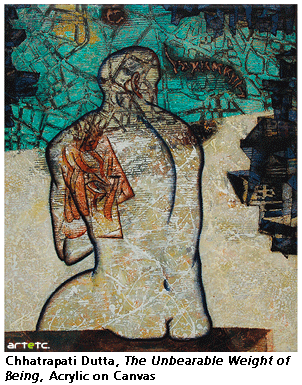
New media artists have always seen their practice as an attempt to make changes in the perception of the social and cultural future through their interaction with the audience. These new media artists set out to create an artwork that will instigate in the audience perceptions, understandings of their own creative potential. There can be little value in mainstream social life. What is politically most fertile they ask? The marginal, mad, deviant, perverse, transgressive- stands askew to a society as a whole. The white males have been strung metaphorically upside down from the lamp posts, while the ill gotten dimes and farthings cascading from their pockets have been used to finance community arts projects.
The logic of the process whereby the fixity of art object is challenged is seen in the increasing degree to which exchange value takes precedence over the usage value. And if we take into consideration the knowledge, in the sense that art might provoke one to an understanding that a video monitor could provide us with must be characterized in some artists' work more as information, the means to something other than the end in itself that is the performance. Art addresses the physiognomy of power: autonomy has ceased to operate as a paradigm because the space in which art functions has dispersed itself within the social fabric. There is no longer a separate realm capable of acting as a container for the ideal solutions to real problems, no longer a safe distance between the dirt of day to day actions and the purity which surrounds ones hopes and aspirations. The two spheres have merged into one complex hyperspace which is as yet incompletely mapped onto our consciousness.
That of the artist's struggle with inhibitions, contradictions, disillusionment, political and personal isolation. Each new step, each new possibility retreats into old solutions and is discarded. But it would be impossible to stop- one has to create the text in spite of the odds. It confronts our traditional experience of sound, of light, of setting-these are wrenched out of context, re-ordered and returned to a new, subtle questioning role of reflecting the artist's choice of subject. Around the early Eighties, for example critics started to take note of the presence of photographs in many galleries around, with some unease and discomfort though accepted today as a valid form of art practice.
 A recurrent issue in the new media most often is the plight of the individual in a highly technological world. However, these works are ultimately optimistic although bristling with images of war, aggression, confrontation, displacement, there is a sense, achieved through ironic focus, that beyond lies something more hopeful but first it is necessary to overturn what we have and create the neutral space from which new things shall grow. A decade back artists began to combine image and text and over the last decade, these works have increased in subtlety and in the interplay of meanings. These are the dissonant and dissident histories and voices that have no place in “modern'. In Sayak Mitra or Shatrughan Thakur, Akhil Chandra Das, Apu Dasgupta, Krishna Sardar the real is not only that which can be reproduced, but which is always already reproduced as in Soghra Khurasani, Piyali Sadhukhan or Alok Prabhakar it became a proxy for the real, a fetishism of the lost object, no longer the object of representation, but an ecstasy of denial and of its own ritual extermination: the hyperreal.
A recurrent issue in the new media most often is the plight of the individual in a highly technological world. However, these works are ultimately optimistic although bristling with images of war, aggression, confrontation, displacement, there is a sense, achieved through ironic focus, that beyond lies something more hopeful but first it is necessary to overturn what we have and create the neutral space from which new things shall grow. A decade back artists began to combine image and text and over the last decade, these works have increased in subtlety and in the interplay of meanings. These are the dissonant and dissident histories and voices that have no place in “modern'. In Sayak Mitra or Shatrughan Thakur, Akhil Chandra Das, Apu Dasgupta, Krishna Sardar the real is not only that which can be reproduced, but which is always already reproduced as in Soghra Khurasani, Piyali Sadhukhan or Alok Prabhakar it became a proxy for the real, a fetishism of the lost object, no longer the object of representation, but an ecstasy of denial and of its own ritual extermination: the hyperreal.
In establishing her art practice Rupa Rani makes stirring references to two interconnected disciplines- archival documentation and semiotics that have become exceptionally important in the last two decades. With her work Rupa Rani moves openly into the field of impersonal and social behaviour: the spectators are asked to work with personal and social choices selected by the artist and the process demands a discussion. Riya Chatterjee's work appears to introduce as introduction to a feminist theme relegated to annotations in a diary. Often she casually mentions her passionate feelings, from time to time in the space there are moments of peace, discontent and stillness, a sense of work done. This has the benefit of deepening the immediate relation of her work and stretches the capacity of intertextuality.
The signified a and referent are now absorbed to the sole profit of the play of signifiers, of a generalized formalization where the code no longer refers back to any subjective or objective reality, but to its own logic. All reality then becomes the place of semiological manipulation, of a structural simulation. Lack is a social product, it is “created, planned, and organized' in accordance with the interests of the dominant class. It is never primary; it is a deliberate creation as a function of a market economy that involves deliberately organizing wants and needs amid an abundance of production; making all of desire teeter and fall victim to the great fear of not having one's need satisfied- a deliberate projection of lack. Even the expensive cell phones never exhaust themselves in the function they serve, and in this excess of presence they take on their significance of prestige- they no longer designate the world but signify the social rank of the possessor. There is no objective presence to the world. The world is signed into existence not by reference to the real but to a code; in Kasa Vinay Kumar's Self Overlapping or Ranjan Kumar Ghosh's Kiss/Miss. In Meenakshi Sengupta at this point one is left to engage in acts of consumption which show is no longer really there. Unconsciously as it could be, the practitioner's sense of humanistic spirit is something that could encompass extensively various modes of expression, depending on varied contexts.
Engaging bodies that the images in Muktinath Mondal or the sculptures of Arindam Sarkar as if retrieved from the times and spaces one has navigated inwardly and intensely with their indiscriminate abandon and unconfined. It is necessary for the act to follow an internal spontaneous spirituality and become a self-generating organism. Vinita Dasgupta's act of painting makes multiple entries, her acrylics on canvas or transferring of digital. Santosh Andrade's work speaks calmly in virtue of a different stance, an authentic attitude. In his recent work done in acrylic on canvas, a greater complexity is evident, as the fragmentation between image and means becomes less intrusive, through a more supple and fluid handling, the more intricate spatial structure, the Madhubani inscriptions and the more subtle use of light. Elegiac, almost melancholy, the mood of his work 'the courtyard of memories' imbues not only this theme, but great deal of his language.
 We shuttle between the different spaces though, dividing into partisan, watching selves as we do: each mode captures an aspect of the idea, and the complementary versions overlap. The eclecticism of visuality that led up to the piling of some images here as in Nabanita Guha, Sagar Bhowmick, Sukanya Ghosh, Siraj Saxena, Mithun Dasgupta, Sumana Ghosh or H.G. Urala. From diverse visual sources on one visual space as the last two decades brought to effect an ambivalent language of collage and citation facilitating juxtaposition of Indian and Western, traditional and modern, national and subaltern, sacred and erotic elements, between the mythical and colonial, between celestial and terrestrial, shifting of locales and characters, transfer from one time, place and genre to another, on a single receptor surface and a mode of contemporary articulation of an anti-colonial allegorical and metaphorical infrastructure in place for politics and living.
We shuttle between the different spaces though, dividing into partisan, watching selves as we do: each mode captures an aspect of the idea, and the complementary versions overlap. The eclecticism of visuality that led up to the piling of some images here as in Nabanita Guha, Sagar Bhowmick, Sukanya Ghosh, Siraj Saxena, Mithun Dasgupta, Sumana Ghosh or H.G. Urala. From diverse visual sources on one visual space as the last two decades brought to effect an ambivalent language of collage and citation facilitating juxtaposition of Indian and Western, traditional and modern, national and subaltern, sacred and erotic elements, between the mythical and colonial, between celestial and terrestrial, shifting of locales and characters, transfer from one time, place and genre to another, on a single receptor surface and a mode of contemporary articulation of an anti-colonial allegorical and metaphorical infrastructure in place for politics and living.
The present practices/new media provokes a dialogue that will not question our own notion of culture and society but will also affect how we imagine ourselves. We hope that the forthcoming issues shall provide an insight into the condition of contemporary art in India and the opportunity for many questions regarding the idea of “identity” and to what extent we stretch ourselves.